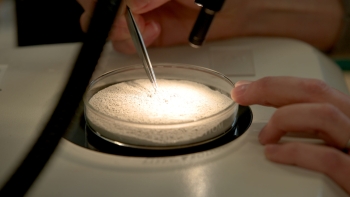NASA has been working with a robotics and artificial intelligence group to hammer out construction methods for a Moon outpost.
Part of that partnership is characterizing the lunar topside to understand the Moon’s exact regolith makeup – creating a library of lunar dust and associated bits and pieces.
In November 2022, NASA selected ICON for a $57.2 million grant to develop lunar construction technology. ICON’s primarily feedstock for structures on the Moon is using local lunar resources as building materials, putting to use 3D-printing technology.
However, minerals and glass in lunar soil vary widely from sample to sample and the 3D-printing process is sensitive to changes in mineralogy.
Extraterrestrial minerals
To help move lunar construction concepts forward, a research task is underway at Northwestern University in Evanston, Illinois. The idea is to create a library of potential lunar sample compositions using what’s called “simulants” to optimize the building process on the Moon.
Northwestern University mineralogist Steven Jacobsen has received funding from NASA’s Marshall Space Flight Center to develop that lunar sample library.
“Off-world construction comes with many challenges,” said Jacobsen, the project’s principal investigator.
“The Moon’s soil is not like that on Earth. On the Moon, soil is formed from meteoroid impacts that have crushed the surface. So, the Moon is essentially coated in a thick layer of pulverized flour. The types of minerals and glass found in lunar soil depend on many factors. The material can vary widely within even a small area,” Jacobsen said in a university statement.
Moon bricks
Jacobsen pointed out it’s not feasible to send conventional Earth-based construction equipment and materials to the Moon. The payload would be too heavy, he said.
“So, this plan is a lot more practical,” Jacobsen said. “Just as the first bricks on Earth were made out of terrestrial soil, the first bricks on the Moon will be made out of lunar soil.”
The task at hand is to anticipate the likely variability in lunar soil and come up with a way to measure it on the fly, onboard a 3D printer.

Various samples of lunar soil simulants in the lab.
Image credit: Shane Collins/Northwestern University
Once the variability in realistic lunar sample is determined, the next step is to probe how the composition of lunar materials can affect the melting process used in robotic construction.
Melting point
Once planted on the Moon, ICON’s lunar construction systems would scoop up lunar soil and melt it for printing. After printing, the melted dirt will harden and cool into a ceramic material.
“Different minerals in lunar dirt melt at different rates,” Jacobsen noted, “so the 3D-printing process is very sensitive to changes in mineralogy.”
One scoop of lunar topside might have a different melting point than the next scoop. The 3D-printing technology needs to be nimble enough to know how to handle these subtle differences.
Scoop diagnostics
By having a sample library, a 3D printer can be ready for all possible lunar material mixes, performing diagnostics of each scoop and then adjusting the printer’s laser parameters for heating and cooling.
“Without understanding the characteristics of the soil, it’s difficult to understand the variability of the final printed materials,” Jacobsen said.
“Using the library that we create from simulants — cross-checked against the lunar soil — the printer will know how to process each piece to produce the best ceramic,” Jacobsen added. “That detailed library of information will play a part in making the imagined outpost a reality.”
ICON’s Project Olympus is a space-based construction system under active development to support the future exploration of the Moon with NASA and for commercial lunar construction projects. The Olympus construction system is being designed and engineered to construct landing pads, roadways, non-pressurized structures,
and pressurized habitats.
Image credit: ICON



